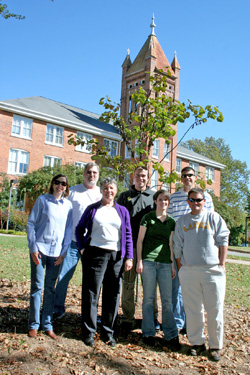 A chance meeting in May between a group of Lander University students and a survivor of the Invasion of Normandy recently resulted in the appearance of a new tree on Lander's front lawn.
A chance meeting in May between a group of Lander University students and a survivor of the Invasion of Normandy recently resulted in the appearance of a new tree on Lander's front lawn.
The students were in France with the "Battlefields/Battlefilms" tour led by Dr. Jean Paquette, professor emeritus of history, and Dr. Misty Jameson, assistant professor of English and film studies.
The veteran's name is John Smitherman, and the meeting took place on Utah Beach, 66 years after Smitherman and the rest of the 4th Infantry Division came ashore during the Invasion of Normandy on June 6, 1944.
"One memory I have is the walking stick he had, and watching him point with it to the spot on the beach where he believed he had come ashore. That was pretty neat," said Jonathan Smith, a senior political science major from Fountain Inn.
The 4th Infantry Division was the first Allied unit to land during what became the largest amphibious assault in history. Initially, losses were light, but the 4th Division's luck would not hold.
"The next day, we had to take [the gun emplacements above them] out because they were giving the ships so much trouble," writes David Roderick, a sergeant with the 22nd Regiment of the 4th Infantry Division and author of "Utah Beach: Story of Fourth Division and Support on D-Day." "We lost a lot of men attacking the fortifications."
By May 2, 1945, when the 4th was deactivated, it had suffered 22,454 combat casualties, the most of any American division in the European Theater of Operations.
Former Greenwood County Sheriff Giles Daniel's older brother, James Lawrence, and his best friend, Vern Holley, were 3rd Army soldiers attached to the 9th Infantry Division. They also landed at Utah Beach, four days after Smitherman.
Holley and Lawrence Daniel, whose wife, Mayo, had written to tell him she was pregnant with their first child, were not so fortunate as Smitherman. On July 18, near St. Lo, Lawrence Daniel was wounded. He died the next day. Within 24 hours, Holley had been cut down, too.
Former Sheriff Daniel was a sailor serving aboard the U.S.S. Hornet in the Pacific when he was informed of his brother's death.
He remembered his brother's prewar vocation, running the "dope wagon" that brought cokes and sandwiches to employees of Greenwood Mills, and learning to drive in Lawrence's '36 Ford.
"He was a good brother," said Daniel, now 85. "He was a mighty fine person."
James Lawrence Daniel Jr., of McCormick, who was born December 20, 1944, never knew his father. "I only had stories about what kind of man he was and what kind of personality he had," he said.
He was fortunate in one way. "I had several uncles, and they took up time with me," he said.
Like Smitherman, he was drawn to the place where so much blood had been shed, and in 2001, he brought his mother, who remarried in 1948, to the American Cemetery in Normandy to visit the graves of his father and Holley.
"Neither she nor I had ever been there," he said.
His mother died two years later.
Jonathan Smith, one of the students who came up with the idea to dedicate a tree to Smitherman, said the veteran from Alabama told him and the others from Lander that it was his first trip back to Normandy, too.
Smith characterized the meeting with Smitherman as the "highlight" of the Lander students' trip.
Gene McDaniel, a local veteran with 38 years of service, applauded the impulse that led the students to recognize Smitherman, calling it "a great idea to plant a tree in his honor."
Dr. Paquette, whose trip made the meeting with Smitherman possible, remembered how the students "got so excited that here was a guy who was in it and actually survived."